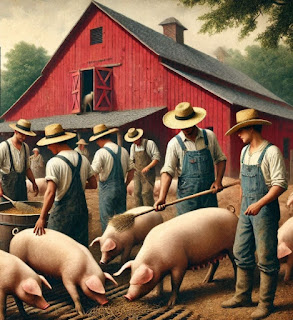Hog farming was an important aspect of agriculture in Pocahontas County, West Virginia, as evidenced by articles and advertisements in the Pocahontas Times during 1909-1910 and 1915-1916. The sources offer insights into various practices and challenges related to hog raising in the region.
Hog Farming Practices
The Times articles emphasize the importance of proper feeding and management for successful hog raising:
- Pasture and Grain: Hogs raised for the fall and winter market thrived in pastures with good grass and clover, supplemented with a daily ration of shelled grain like corn. Farmers believed that this method produced pork efficiently and cost-effectively.
- Supplementary Foods: The high price of corn in 1909 encouraged farmers to explore alternative feeds to stretch their corn supply. The Times recommended using pasture, skimmed milk, slop, and other supplementary foods to reduce reliance on corn.
- Salt and Ashes: Experienced breeders advised providing hogs with access to salt and ashes. They observed that pigs readily consumed this mixture, especially after eating grain, and believed it contributed to better bone growth and overall health.
Challenges and Concerns
The Times also addresses several challenges faced by hog farmers:
- Parasites: Pasturing sheep on the same land for multiple years raised concerns about parasite infestations. However, some farmers successfully controlled parasites by using a mixture of tar, turpentine, and salt.
- Disease: Dusty housing conditions were linked to persistent coughs in hogs, often indicating worm infestations. Copperas dissolved in water was a recommended remedy for this problem. The sources also document an outbreak of forage poisoning affecting livestock in 1915. Veterinarians noted that this condition mimicked symptoms of the more serious foot and mouth disease.
- Predation: Foxes posed a significant threat to poultry and game in Pocahontas County, as reported in November 1915. One farmer lost twenty-one turkeys in a single night to a fox. The Times highlighted the financial losses associated with such predation, emphasizing the impact on farmers' incomes.
Economic Aspects
The economic significance of hog farming is evident throughout the Times articles:
- Market Prices: The high price of hogs in 1909 made it a potentially profitable venture for farmers. The sources also report fluctuating lamb prices, influenced by factors like political administrations.
- Marketing: Advertisements in the Times sought live poultry and dressed turkeys for the Christmas market, indicating demand from urban areas. These ads emphasized the importance of proper dressing and packing to fetch the best prices, reflecting the commercial nature of hog and poultry farming.
Other Relevant Information
The Times occasionally features anecdotes and observations related to hogs:
- Hog Ringing Device: A December 1909 article describes a homemade device for ringing hogs, demonstrating practical ingenuity in farm management.
- Souse Production: A humorous piece from December 1910 extols the virtues of souse, a traditional dish made from hog parts, suggesting its cultural significance in the region.
The Pocahontas Times provides a glimpse into the multifaceted nature of hog farming in Pocahontas County, encompassing practical advice, challenges, economic considerations, and even cultural aspects. These sources illuminate the importance of hogs in the local agricultural landscape and offer valuable historical context for understanding rural life in early 20th-century West Virginia.



No comments:
Post a Comment